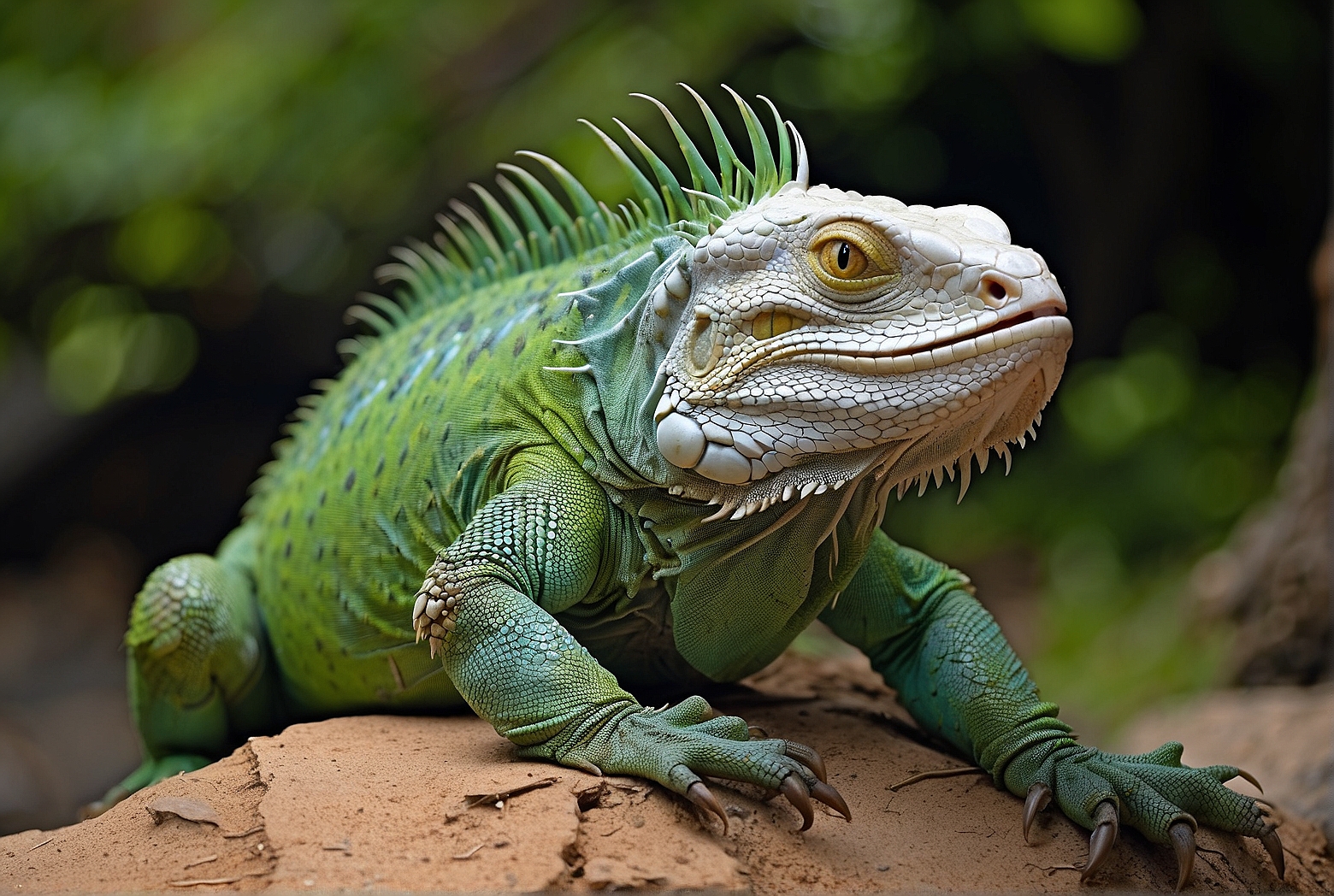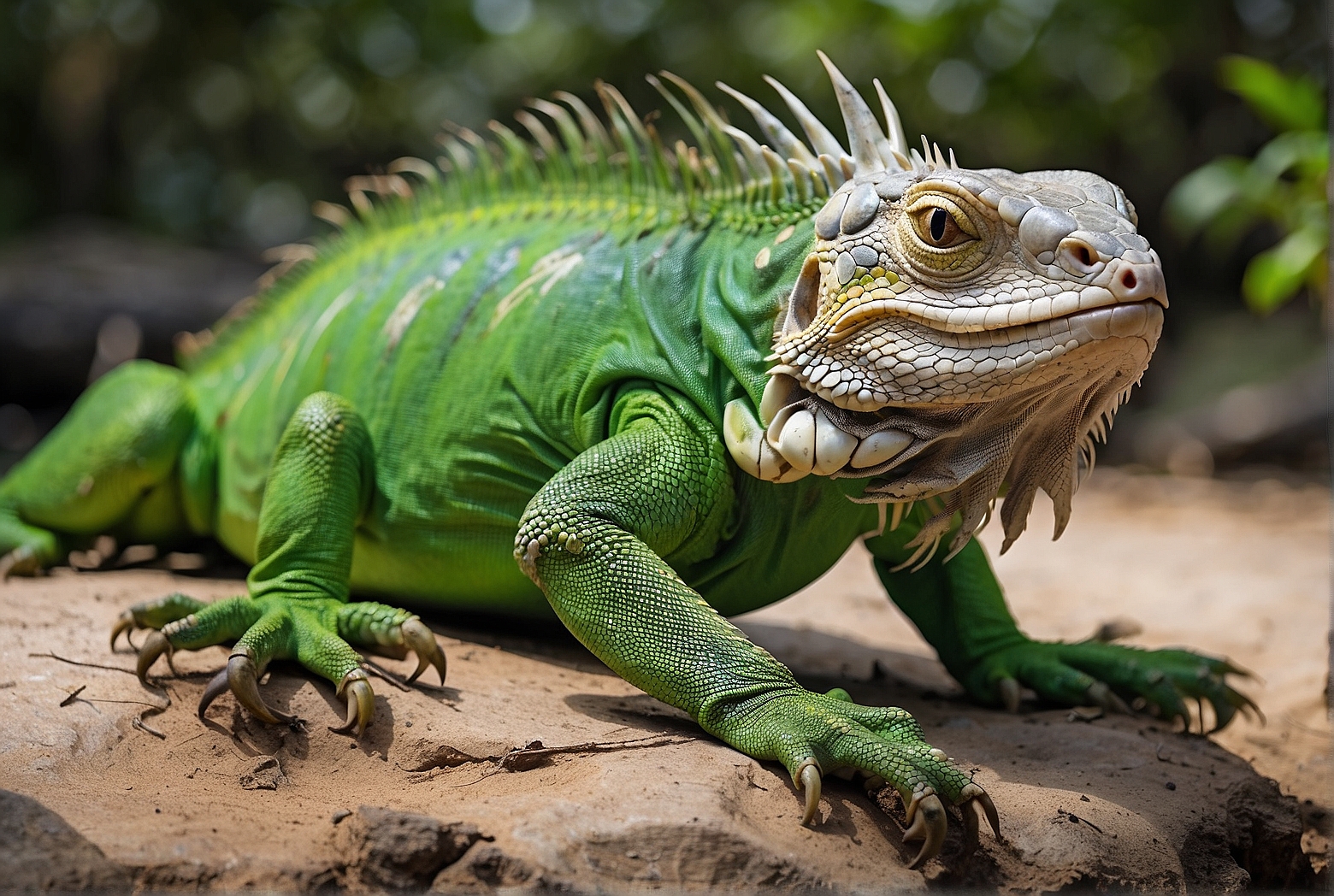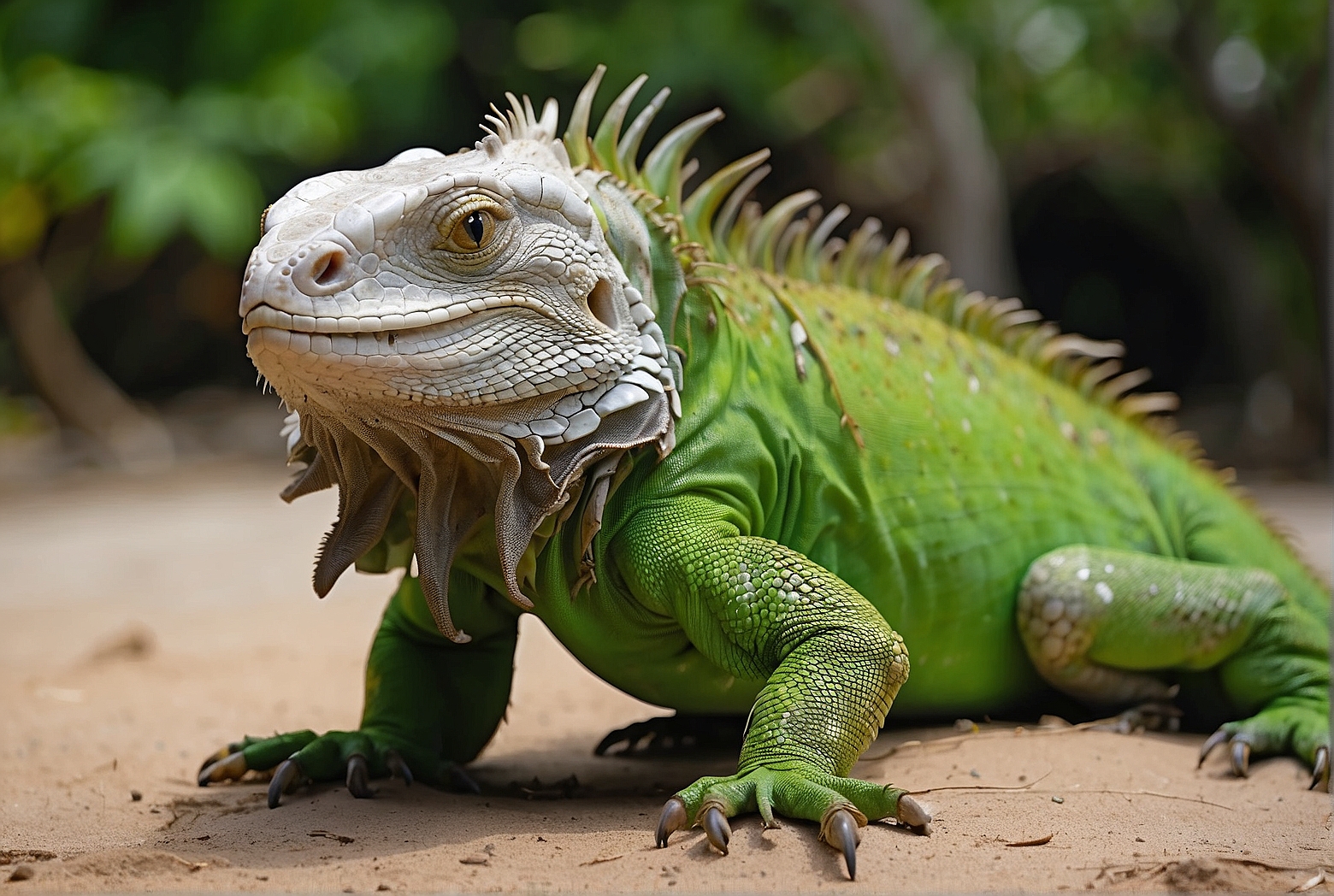Imagine a lush tropical paradise teeming with life, where vibrant green iguanas effortlessly blend into their surroundings. While these majestic creatures may appear harmless, their presence can have a significant impact on the delicate balance of their environment. From altering vegetation patterns to competing with native species, the environmental impact of green iguanas cannot be understated. In this article, we will explore the ways in which these mesmerizing reptiles shape their surroundings and the consequences it has on the ecosystems they inhabit. Brace yourself for an eye-opening journey into the world of the green iguana and its hidden effects on the environment.
Habitat Destruction
Habitat destruction refers to the process by which the natural habitat of a particular area is modified or completely eliminated. It has significant consequences for both native plant and animal species. When green iguanas invade an area, they can cause extensive habitat destruction through their feeding and nesting habits. As these reptiles are primarily herbivorous, they readily consume and harm native vegetation, leading to the decline in native plant species. The loss of these plants not only affects the aesthetic appeal of the environment but also disrupts the delicate balance of the ecosystem.
Impact on Native Plant Species
Green iguanas pose a serious threat to native plant species. With their voracious appetite for foliage, they consume large quantities of vegetation, causing a significant reduction in plant diversity. As native plants are often slow-growing and sensitive to disturbances, their ability to recover and regenerate is compromised. This can result in the loss of crucial food sources, shelter, and breeding grounds for other organisms in the ecosystem.
Impact on Native Animal Species
The invasion of green iguanas also has a detrimental impact on native animal species. As the iguanas compete for limited resources, such as food and nesting sites, with native animals, they can disrupt the delicate balance of the ecosystem. Native animal species may struggle to find sufficient food or may be displaced from their preferred habitats due to the presence of green iguanas. This can lead to a decline in population numbers and even local extinctions, causing irreversible damage to the biodiversity of the area.
Competition for Resources
Green iguanas are known to be highly competitive when it comes to resources such as food, water, and nesting sites. They outcompete native animals, including reptiles, birds, and small mammals, for these essential resources. This competition can have severe consequences for the native species, as they may be unable to access the resources they need to survive and reproduce. As a result, a displacement of native species occurs, leading to an imbalance in the distribution and availability of resources within the ecosystem.
Predation
Predation refers to the act of preying on other organisms for sustenance and often has a significant impact on ecosystems. In the case of green iguanas, their feeding habits and voracious appetite can have severe consequences for local fauna, particularly smaller animals and insects.

Feeding Habits of Green Iguanas
Green iguanas are primarily herbivorous and consume a wide variety of vegetation. This includes leaves, flowers, fruits, and even bark. Their ability to consume such a diverse range of plant material provides them with a competitive advantage over native herbivores. As a result, green iguanas have the potential to overconsume specific plant species, leading to potential declines in vegetation that other organisms rely on for survival.
Impact on Local Fauna
The presence of green iguanas in an area can have a detrimental impact on local fauna. Small animals, such as lizards, insects, and invertebrates, may fall victim to predation by green iguanas. These reptiles are opportunistic feeders and will take advantage of any available food source, including smaller animals. The loss of these smaller animals can disrupt the delicate ecological balance, as they may serve as prey for larger predators or play critical roles in nutrient cycling and seed dispersal.
Threat to Endangered Species
The predation by green iguanas poses a significant threat to endangered species within their invaded habitats. Endangered animals, already vulnerable due to habitat loss or other factors, may face increased predation pressure from green iguanas. This can further jeopardize their survival and push them closer to extinction. Conservation efforts must prioritize protecting these endangered species from the predation of green iguanas to ensure their long-term survival.
Ecosystem Disruption
The presence of green iguanas in an ecosystem can cause substantial disruptions that go beyond the direct impacts on plant and animal species. These disruptions often manifest in changes to nutrient cycling, alterations in plant composition, and the overall interactions between species within the ecosystem.
Altering Nutrient Cycling
Green iguanas play a role in disrupting the nutrient cycling within an ecosystem. As they consume vegetation, they affect the decomposition and nutrient release processes. When green iguanas consume plants, they remove nutrients that would otherwise be recycled back into the soil through the decomposition of dead plant material. This can lead to nutrient imbalances and reduced soil fertility, affecting the growth and health of remaining plants and the animals that depend on them.
Changes in Plant Composition
The feeding habits of green iguanas can lead to changes in the composition of plant species within the invaded ecosystem. As green iguanas prefer certain plant species over others, they can significantly decrease the abundance and diversity of the plants they consume. This change in plant composition can create a domino effect, affecting the availability of food and habitat for other organisms. The loss of plant species diversity can also compromise the long-term resilience and stability of the ecosystem.

Impact on Species Interactions
Green iguana invasions can disrupt the intricate web of species interactions within an ecosystem. By competing with native animals for resources and preying on smaller animals, they alter the dynamics of the ecosystem. For example, the decline in plant species diversity due to green iguana feeding can affect the interactions between plants and their pollinators. This disruption can disrupt the mutualistic relationships between plants and pollinators, resulting in reduced pollination rates and potential reproductive failures for both plants and their pollinators.
Spread of Disease
Apart from their ecological impacts, green iguanas also pose risks as disease carriers, contributing to the spread of pathogens within the environment. This can have severe consequences for both native species and even human health.
Carriers of Pathogens
Green iguanas can harbor and spread various disease-causing pathogens, including parasites and bacteria. As they move through an invaded habitat, they can potentially transmit these pathogens from one organism to another. This can lead to increased disease prevalence and even outbreaks among native species, further compromising their health and contributing to population declines.
Transmission to Native Species
The transmission of pathogens from green iguanas to native species poses a significant concern for the health and survival of native wildlife. As green iguanas come into contact with native animals during their movements and interactions, the transmission of diseases can occur. Native species, potentially lacking the necessary defenses or immunity against these pathogens, may suffer from increased susceptibility to infections and diseases. This can lead to increased mortality rates and population declines in native wildlife, further disrupting the ecosystem dynamics.
Health Risks to Humans
Beyond the ecological implications, green iguanas also pose health risks to humans. Direct contact with green iguanas or their feces can potentially result in the transmission of zoonotic diseases. Salmonella bacterial infections are of particular concern, as green iguanas can harbor and shed these pathogens. The presence of green iguanas in urban areas can increase the potential for human exposure, highlighting the importance of awareness and proper hygiene practices when encountering these reptiles.
Economic Damage
The invasion of green iguanas can also result in significant economic damage, impacting multiple sectors, including agriculture and infrastructure. The costs associated with controlling and managing green iguana populations further add to the economic burden.
Agricultural Impact
Green iguanas can have devastating effects on agricultural production. As herbivores, they often target agricultural crops, including fruits, vegetables, and ornamental plants. The damage caused by their feeding habits can lead to substantial economic losses for farmers, as crops are destroyed or rendered unsellable. Additionally, the invasion of green iguanas can necessitate costly measures, such as the installation of fencing or the use of deterrents, to protect agricultural fields from further damage.
Infrastructure Damage
Green iguanas have the potential to cause damage to infrastructure elements, including buildings and structures. Their burrowing activities can weaken foundations and cause structural damage, particularly in urban areas where green iguanas seek shelter and nesting sites. The costs associated with repairing and reinforcing infrastructure can be significant and may impact local communities and municipalities financially.
Cost of Control and Management
Implementing control and management strategies to mitigate the impacts of green iguana invasions can place a financial burden on governments, conservation organizations, and local communities. Expensive initiatives, including trapping and removal programs, hunting and culling efforts, and biocontrol measures, require significant funding and ongoing resources. The costs associated with monitoring, research, and public education campaigns aimed at raising awareness add further economic strain.
Impact on Indigenous Culture
The presence of green iguanas and their environmental impacts also have implications for indigenous cultures, their practices, and their traditional knowledge systems.
Traditional Uses and Knowledge
In many indigenous cultures, green iguanas hold cultural significance and are a part of traditional practices and knowledge systems. The invasion and subsequent decline in green iguana populations can disrupt these cultural practices, reducing opportunities for traditional uses such as food, medicine, or ceremonial purposes. The loss of this connection to green iguanas can erode the cultural identity and heritage of indigenous communities.
Cultural Significance
Green iguanas often hold cultural significance and may be woven into the mythologies, stories, and art of indigenous cultures. They can symbolize certain values, characteristics, or spiritual beliefs. With the invasion of green iguanas and their impact on the environment, indigenous cultures may experience a loss of cultural significance tied to these reptiles. The preservation of indigenous cultural heritage relies on the protection and conservation of the species intertwined with their traditions.
Loss of Cultural Practices
Indigenous communities may practice sustainable and resourceful approaches to interacting with green iguanas and their habitat. The invasion of green iguanas can disrupt these practices, leading to a loss of traditional knowledge and skills passed down through generations. The loss of these cultural practices not only impacts indigenous communities’ way of life but also removes valuable contributions to the broader understanding and conservation of the environment.
Negative Effects on Biodiversity
Green iguana invasions have detrimental effects on biodiversity, with specific impacts on overall species diversity, ecosystem functioning, and food chain dynamics.
Reduction of Species Diversity
The invasion of green iguanas can result in a reduction of species diversity within the impacted ecosystem. Their ability to outcompete native species and negatively impact plant and animal populations can lead to a decline in overall species richness. This loss of species diversity decreases the ecosystem’s resilience, making it more susceptible to other ecological disturbances and reducing its ability to adapt to environmental changes.
Alteration of Ecosystem Functions
The presence of green iguanas and their impact on the environment can significantly alter ecosystem functions. The loss of key plant species and changes in nutrient cycling disrupt the intricate balance of the ecosystem, affecting processes such as primary productivity, decomposition, and energy flow. These alterations can have far-reaching consequences, ultimately influencing the stability and health of the ecosystem as a whole.
Imbalance in Food Chains
Green iguanas can disrupt food chains within an ecosystem. As they compete with native animals for resources and predate on smaller animals, they can cause imbalances in the predator-prey relationships. The decline in population numbers or even local extinctions of certain native species can have cascading effects throughout the food chain, potentially leading to disruptions in community structure and overall ecological stability.
Climate Change Implications
The environmental impacts of green iguanas, particularly their habitat destruction and alterations in ecosystem function, have implications for climate change dynamics and feedback loops within an ecosystem.
Effect on Carbon Sequestration
Green iguanas can indirectly influence carbon sequestration processes within an ecosystem. By causing habitat destruction and altering plant composition, they can impact the rate at which carbon dioxide is removed from the atmosphere and stored in vegetation. A decrease in plant biomass due to green iguana feeding can potentially impact the ecosystem’s ability to mitigate climate change by reducing the sequestration of carbon.
Changes in Microclimates
The presence of green iguanas can lead to changes in microclimates within an ecosystem. As they consume specific plant species and alter the overall structure of vegetation, the microclimate conditions, such as temperature and humidity, can be affected. These changes can have cascading effects on other organisms within the ecosystem, modifying their habitat suitability and potentially leading to shifts in species distributions or even local extinctions.
Feedback Loop Mechanisms
The environmental impacts caused by green iguanas can initiate feedback loop mechanisms that further exacerbate the effects of climate change. For example, the reduction in plant biomass due to green iguana feeding can increase soil exposure, leading to increased soil erosion. This erosion can release stored carbon into the atmosphere, contributing to greenhouse gas emissions and exacerbating climate change impacts. These feedback mechanisms highlight the interconnectedness of ecological processes and the importance of considering the broader implications of invasive species management.
Control and Management Strategies
To mitigate the environmental, economic, and social impacts of green iguana invasions, a range of control and management strategies can be employed. These strategies aim to limit green iguana populations and their ecological effects.
Trapping and Removal Programs
One common control strategy involves trapping and removing green iguanas from invaded areas. Trapping can be an effective method to reduce population numbers and prevent further reproduction. Trapped green iguanas can be relocated to areas where their impact on native species and ecosystems is minimal. However, the implementation of trapping and removal programs must consider ethical and potential welfare issues, ensuring that these methods are carried out safely and humanely.
Hunting and Culling
In some regions, hunting and culling programs are utilized as a means of controlling green iguana populations. These efforts involve the regulated hunting of green iguanas to reduce their numbers and minimize their impacts on the environment. Hunting and culling must be managed carefully to avoid unintentional impacts on non-target species and should always align with sustainable hunting practices.
Biocontrol Measures
In certain situations, the use of biocontrol measures can be considered to manage green iguana populations. These measures involve the introduction or promotion of natural predators or parasites that specifically target green iguanas. The introduction of biocontrol agents must be undertaken cautiously, with thorough risk assessments to ensure that unintended ecological consequences are avoided.
Conservation Efforts
While the focus is often on controlling and managing green iguana populations, conservation efforts are also essential to protect native species and restore damaged habitats.
Protecting Native Species
Conservation efforts should prioritize protecting native species affected by green iguana invasions. This can involve implementing measures to minimize direct predation on native animals or establishing protected areas where endangered species can thrive. By actively safeguarding native species, their populations can recover, contributing to the restoration of the ecosystem’s biodiversity.
Restoring Damaged Habitats
Efforts should be made to restore habitats damaged by green iguana invasions. This can involve replanting native vegetation, removing competing invasive species, and creating suitable conditions for the recovery of plant and animal communities. Habitat restoration projects are crucial in promoting the recovery and resilience of ecosystems impacted by green iguana invasions.
Education and Awareness
Education and awareness campaigns play a vital role in addressing the environmental impact of green iguanas. By raising public knowledge about their ecological effects, as well as providing information on effective control and management strategies, individuals can make informed decisions and actively contribute to conservation efforts. Engaging local communities, schools, and stakeholders in these campaigns fosters a sense of ownership and promotes behavioral changes that support the protection of native species and their habitats.
In conclusion, the invasion of green iguanas has far-reaching and multifaceted environmental impacts. From habitat destruction and predation to ecosystem disruption and the spread of disease, these reptiles pose significant challenges to native species, biodiversity, and even human health. The economic ramifications of green iguana invasions and the socio-cultural implications for indigenous communities cannot be ignored. To mitigate these impacts, control and management strategies, as well as conservation efforts, must be implemented. Protecting native species, restoring damaged habitats, and fostering education and awareness are critical components of a comprehensive approach to address the environmental impact of green iguanas effectively.
